
PREV ARTICLE
NEXT ARTICLE
FULL ISSUE
PREV FULL ISSUE
REVIEW: GORNY & MOSCH SPRING 2014 SALES
Ursula Kampmann also submitted an extensive review of the latest Gorny & Mosch sales. Thanks! More beautiful coins here.
-Editor
More than a quarter of a million euros for four rarities from Czechoslovakia Even though there were many remarkable results to be witnessed in the Gorny & Mosch auction sale conducted between 10 and 12 March 2014, one ought to be singled out: a set comprising four extremely rare gold coins from Czechoslovakia from 1938 that changed hands for 282,000 euros. Every auction has its own surprises. With auction 221 of Gorny & Mosch it was lot 3498 with four gold coins, known as being rare, from the Republic of Czechoslovakia dating to 1938. The rather modest estimate had been 15,000 euros. The proud new owner, however, had to pay a bit more for these rarities. His invoice will amount to 282,000 euros*. The reason for this high price was that the four pieces on offer are particularly scarce: only 186 specimens were being produced of the ducat, another 56 of the double ducat, 192 of the 5 ducat piece and 16 of the 10 ducat piece. It staggers the imagination to consider what such a set might have obtained if it had consisted of Russian or Chinese coins. Modern coins from Czechoslovakia rising to such a price range clearly indicate how intense the interest in numismatics has become in this country of the former Eastern bloc. This is by far the highest result achieved in the three spring auctions of the Munich auction house although other items obtained truly remarkable prices as well.
Auction sale 219 – High-quality ancient coins An art lover paid 13,000 euros for it in the end. The same sum was paid for an extremely fine didrachm from Croton with a slightly off-center obverse and a depiction of Hercules strangling the snakes on the reverse, which originally had been significantly underestimated with its 1,200 euros. A third didrachm obtained the very result. It comes from Camarina and shows the Nymph on a swan on its obverse. The estimate of the attractive piece had been 2,500 euros. Many collectors were anxious to see what the Archaic tetradrachm from Naxos might yield. Its reverse was very fine to extremely fine but its obverse exhibited traces of corrosion and hence could only be graded very fine. In the previous years, it had been rather difficult to sell such imperfect coins regardless of their good provenance – this coin goes back to the Ward Collection that was auctioned off in 1973. The modest estimate of 8,000 euros, on the other hand, took full effect. After having paid 47,000 euros, its new owner will be able to add this icon of Greek numismatics to his collection. Comparatively modest appears the result of the tetradrachm of the city of Potideia located in Northern Greece. In all probability, this was the best preserved specimen featuring Poseidon Hippios on the reverse. However, the piece ‘only’ rose to 28,000 euros on a pre-sale estimate of 20,000 euros. The most expensive item of the sale of ancient coins – and its estimate had already anticipated that – became the octodrachm of the Edones tribe with the theft of Hermes on the obverse. It was sold for 88,000 euros. Let’s have a look at the Romans, too. The trend for well-preserved Roman gold to obtain high prices continues unabatedly. Thus, an extremely fine aureus of Trajan with the façade of the Forum Traiani on the reverse brought 17,500 euros (10,000 euros), a good extremely fine aureus of Hadrian featuring the personification of Africa 47,000 euros (25,000 euros) and a perfect solidus of Aelia Verina 54,000 euros (25,000 euros).
Auction sale 220 – Ancient coins and multiple lots Another result from the offer of literature that consisted of meaningfully assembled lots addressing individual topics deserves mention here as well. Lot 2123 comprising four volumes on the coinage of Northern Greece obtained a significantly higher price than the other lots (100 euros, 1,300 euros), even though – of perhaps because of – two of them being written in Bulgarian.
Auction sale 221 – Medieval and modern times The small series of coins from Würzburg likewise was a good seller. The most expensive items were a 5 ducat piece from 1652 (EF-FDC, 25,000 euros, 37,600 euros) and a 5 ducat piece from 1702 (EF-FDC, 10,000 euros, 16,500 euros). It came as no surprise that the splendid imitations of ancient coins created by the best Renaissance die cutters found many friends and bidders. A medal on Antinoos, made around 1550 and having been estimated at 5,000 euros, depicting a wonderful temple façade on the reverse changed hands for 10,500 euros, just like the medal on Queen Artemisia created by Alessandro Cesati, nicknamed il Grecchetto, did. The most expensive item of this small series, and deservedly so, was the marvelous medal on Lycurgus by Valerio Belli, called Vicentino. The extremely fine specimen with its fine dark patina rose from 10,000 euros to 20,500 euros. There was only one single order being offered in auction sale 221 but that one was highly coveted, a Pour le mérite with Oak Leaves conferred on Otto Ritter von Rauchenberger. The rare item with original accessories had been called out for 10,000 euros and found itself a new owner for 30,500 euros in the end. Let us conclude this review with some results from the foreign countries: a speciestaler from Denmark about FDC from 1667 that had been called out for 7,500 euros but was sold for 13,000 euros. An extremely rare and extremely fine thaler of Vincenzo Gonzaga (1587-1612) from Mantua increased from 10,000 euros to 14,000 euros, while the even rarer and about FDC scudo of Napoleone Spinola from Ronco from 1669 with its estimate of 30,000 euros changed hands as late as 49,000 euros. An extremely rare ducat from Riga from 1700 in extremely fine to FDC yielded 15,300 euros (10,000 euros) and a Russian 50 zlotych piece from 1829 for Poland obtained 17,600 euros (10,000 euros). The results of the coins from Czechoslovakia have already been mentioned. There is only one thing to be added: a second set comprising of four gold coins on the reopening of the Kremnica Mines from 1934 came with an estimate of 15,000 euros but obtained 23,500 euros still in the end. All results can be found on the internet at http://www.gmcoinart.de/online_katalog . If you are interested in the lots unsold please contact Gorny & Mosch, Giessener Münzhandlung, Maximiliansplatz 20, D-80333 Munich, phone +49 / (0)89 / 24 22 643-0, fax +49 / (0)89 / 22 85 513. Consignments for the upcoming October auction sale 2014 are accepted as of now until 25 July 2014. * All results include 17.5 % buyer’s premium, exclusive of VAT, and are slightly rounded.
No bald guys here, either. What struck me about this batch were the various hairstyles, like the helmet cut on Gamerses Lot 294), the neatly coiffed Hadrian (Lot 403), and the curly Antinoos (Lot 3375). My favorite of the lot though is the long, unkempt mane of Spartan king Lycurgus (Lot 3380).
-Editor
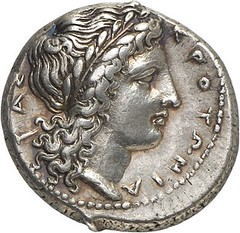
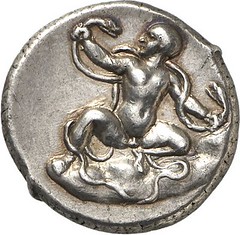
Lot 19: CROTON (Bruttium). Didrachm, c. 390-360 B. C. Extremely fine. Estimate: 1,200,- euros. Final price: 13,000,- euros
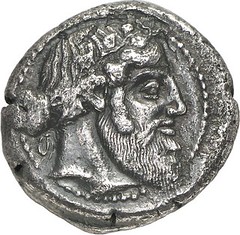
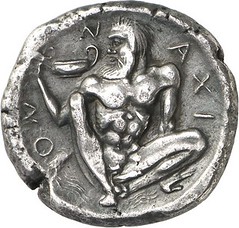
Lot 45: NAXOS (Sicily). Tetradrachm, c. 460 B. C. Ex Ward Coll. (Sotheby’s Zurich 1973), 176. Very rare. Slightly coarse surface. Very fine / very fine to extremely fine. Estimate: 8,000,- euros. Final price: 47,000,- euros
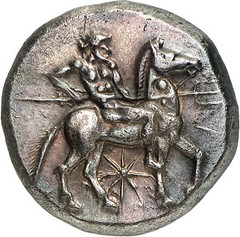

Lot 102: POTIDEIA (Macedonia). Tetradrachm, c. 500-480 B. C. Rare. One of the best preserved specimens. Very fine to extremely fine. Estimate: 20,000,- euros. Final price: 28,000,- euros
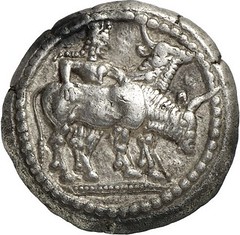
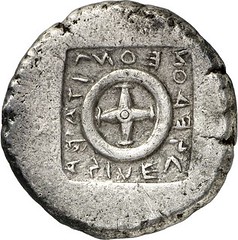
Lot 106: EDONES (Macedonia), Getas. Octodrachm, c. 479-465. Extremely rare variant. About extremely fine. Estimate: 75,000,- euros. Final price: 88,000,- euros
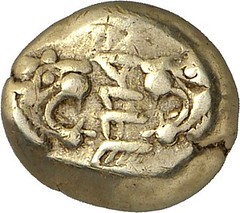
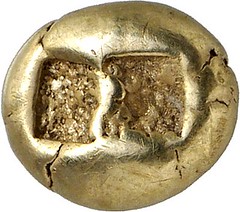
Lot 248: VALVEL (Lydia). Trite, around 650-610 B. C., Sardeis(?). Especially well centered specimen. Very rare. Very fine. Estimate: 3,000,- euros. Final price: 14,000,- euros
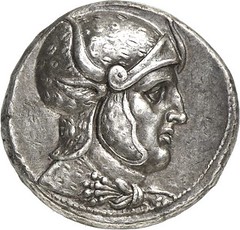
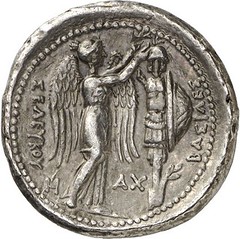
Lot 263: SELEUCUS I, 312-281 B. C. Tetradrachm, c. 305/4-295, Susa. Extremely fine. Estimate: 12,000,- euros. Final price: 17,500,- euros
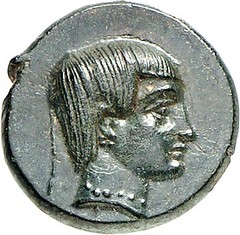

Lot 294: GAMERSES, Persian satrap of Lydia. Bronze, 1st half 4th cent. B. C. Extremely fine. Estimate: 300,- euros. Final price: 2,000,- euros

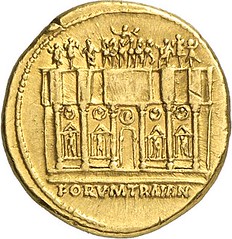
Lot 394: TRAJAN, 98-117. Aureus, 112-114. Rev. FORVM TRAIAN. Edge nick at the rim. Extremely fine. Estimate: 10,000,- euros. Final price: 17,500,- euros
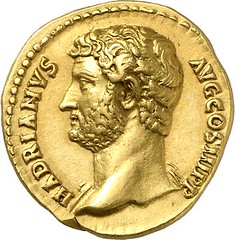
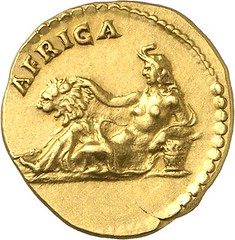
Lot 403: HADRIAN, 117-138. Aureus, 134-138. Rev. AFRICA. Good extremely fine. Estimate: 25,000,- euros. Final price: 47,000,- euros
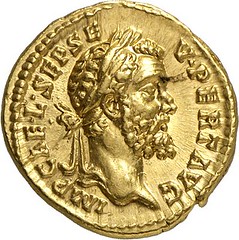
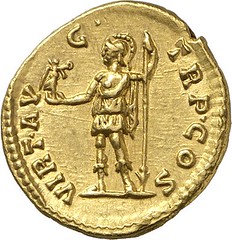
Lot 436: SEPTIMIUS SEVERUS, 193-211. Aureus, 193-194. Rev. Virtus l. Ex Huntington Coll. Extremely fine. Estimate: 20,000,- euros. Final price: 36,500,- euros
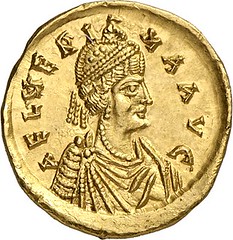
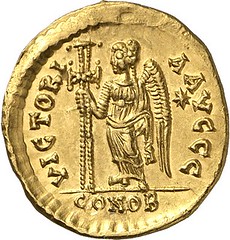
Lot 527: AELIA VERINA, 457-484. Solidus, 462-466. Extremely rare. Extremely fine. Estimate: 25,000,- euros. Final price: 54,000,- euros
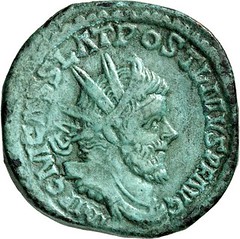
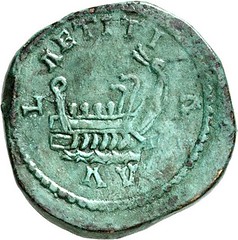
Lot 1759: POSTUMUS, 259-269. Double sestertius, 261, Trier. Light green patina. Very fine. Estimate: 250,- euros. Final price: 1,650,- euros
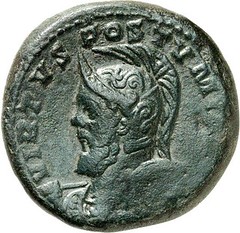
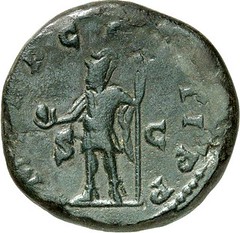
Lot 1766: POSTUMUS, 159-269. Sestertius, Lugdunum. Green patina. Very fine. Estimate: 300,- euros. Final price: 1,400,- euros
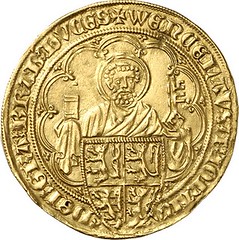
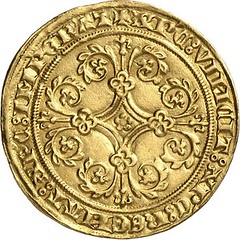
Lot 3109: NETHERLANDS – BRABANT. Johanna and Wenzel, 1355-1383. Pieter d’or. Rare. Extremely fine. Estimate: 1,750,- euros. Final price: 3,750 euros.
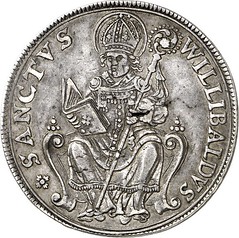

Lot 3201: GERMANY. Eichstätt. Reichsthaler 1606. Mintage: 999 specs. Very fine to extremely fine. Estimate: 7,500,- euros. Final price: 14,000,- euros
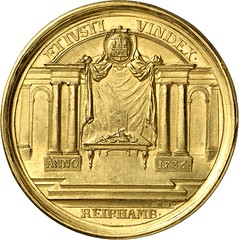
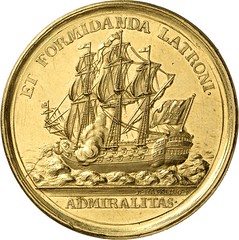
Lot 3210: GERMANY. Hamburg. Portugalöser of 10 ducats 1736. Very rare. Extremely fine to FDC. Estimate: 12,000,- euros. Final price: 19,000,- euros

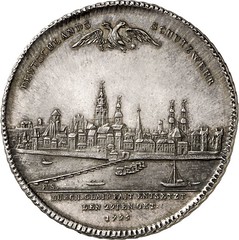
Lot 3249: GERMANY. Mainz. Friedrich Karl Josef von Erthal, 1774-1802. Konventionsthaler 1795, Mainz. Extremely rare. FDC. Estimate: 15,000,- euros. Final price: 20,000,- euros
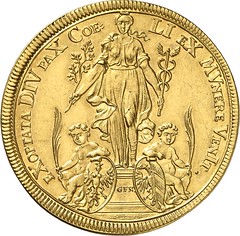
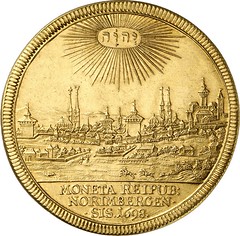
Lot 3256: GERMANY. Nuremberg. Gold pattern of 5 ducats of the thaler 1698 on the Treaty of Ryswick. Very rare. Extremely fine to FDC. Estimate: 18,000,- euros. Final price: 33,500,- euros
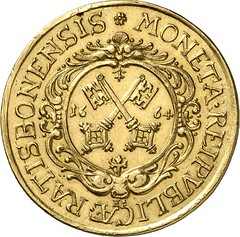
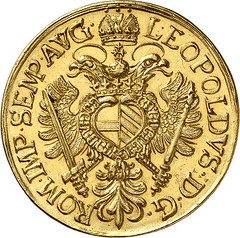
Lot 3266: GERMANY. Regensburg. 4 ducats 1664 HF. Extremely rare. About FDC. Estimate: 20,000,- euros. Final price: 26,000,- euros
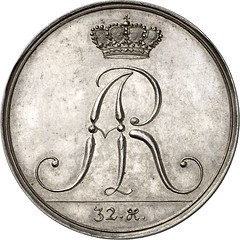

Lot 3277: GERMANY. Saxony. Frederick August I, 1694-1733. Schmetterlingstaler n. d. Extremely rare. About FDC. Estimate: 25,000,- euros. Final price: 40,000,- euros

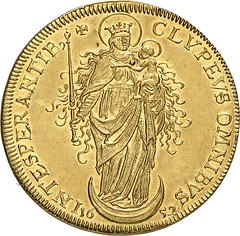
Lot 3315: GERMANY. Würzburg. Johann Philipp I von Schönborn, 1642-1673. 5 ducats 1652, Nuremberg. Very rare. Extremely fine to FDC. Estimate: 25,000,- euros. Final price: 37,500,- euros
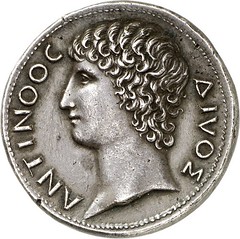
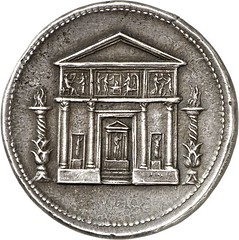
Lot 3375: MEDALS. Medal n. d. (c. 1550) on Antinoos. Extremely rare. Extremely fine. Estimate: 5,000,- euros. Final price: 10,500,- euros
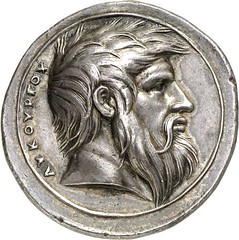
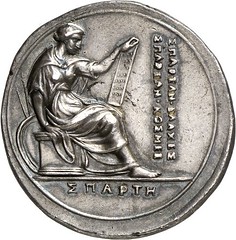
Lot 3380: MEDALS. Valerio Belli, called Vicentino, 1468-1546. Medal n. d. (c. 1539-1542) on Spartan king Lycurgus. From auction sale Astarte 8 (2001), 121. Extremely fine. Estimate: 10,000,- euros. Final price: 20,500,- euros
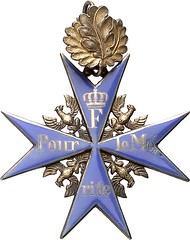
Lot 3391: ORDERS. Prussia. Pour le mérite, 1914-1918. Star of the Order with Ribbon and Oak Leaves for Otto Ritter von Rauchenberger. Very rare. With original accessories. From family property. Very fine to extremely fine. Estimate: 10,000,- euros. Final price: 30,500,- euros

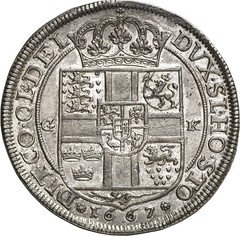
Lot 3417: DENMARK. Frederick III, 1648-1670. Speciesthaler 1667. Very rare. About FDC. Estimate: 7,500,- euros. Final price: 13,000,- euros
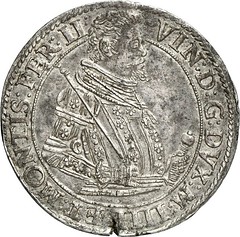
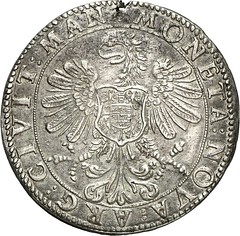
Lot 3437: ITALY. Mantua. Vincenzo I Gonzaga, 1587-1612. Thaler n. d., Mantua. Extremely rare. Extremely fine. Estimate: 10,000,- euros. Final price: 14,000,- euros
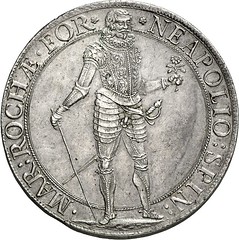
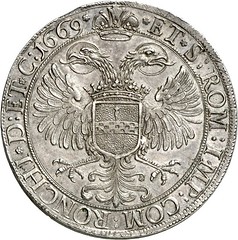
Lot 3439: ITALY. Ronco. Napoleone Spinola, 1647-1672. Scudo (spadino) 1669. Extremely rare. About FDC. Estimate: 30,000,- euros. Final price: 49,000,- euros
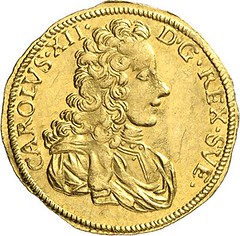
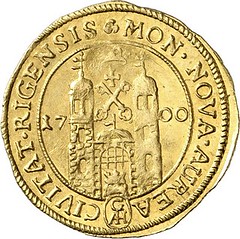
Lot 3455: LATVIA. Riga. Under Swedish dominion. Ducat 1700 GAH Riga. Extremely rare. Extremely fine to FDC. Estimate: 10,000,- euros. Final price: 15,300,- euros
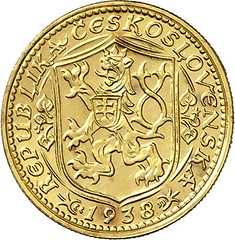
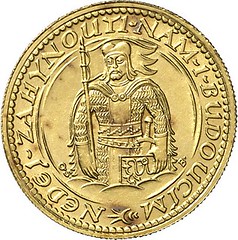
Lot 3498: CZECHOSLOVAKIA. Republic. Lot (4). 10, 5, 2, 1 ducat 1938. Extremely rare. Brilliant uncirculated. Estimate: 15,000,- euros. Final price: 282,000,- euros
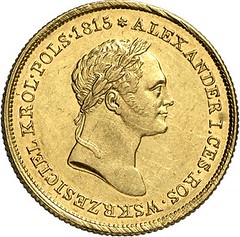
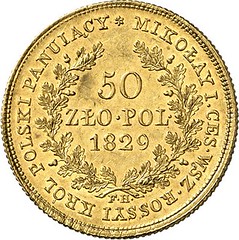
Lot 4053: RUSSIA. Nicholas I, 1825-1855 for Poland. 50 zlotych 1829, Warzawa. Rare. Fine scratches, extremely fine to FDC. Estimate: 10,000,- euros. Final price: 23,500,- euros
The Numismatic Bibliomania Society is a non-profit organization promoting numismatic literature. See our web site at coinbooks.org. To submit items for publication in The E-Sylum, write to the Editor at this address: whomren@gmail.com To subscribe go to: https://my.binhost.com/lists/listinfo/esylum All Rights Reserved. NBS Home Page Contact the NBS webmaster 
|